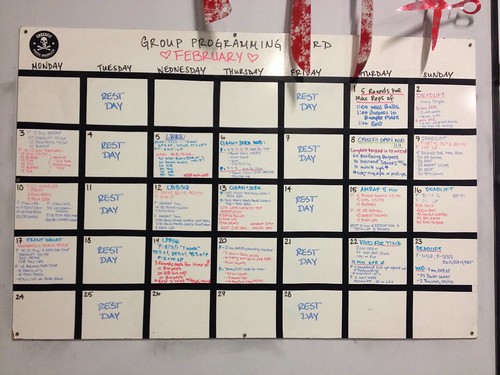Effective Programming Strategies for CrossFit Affiliates
 Monday, February 24, 2014 at 12:00AM
Monday, February 24, 2014 at 12:00AM 
In our popular article "The Benefits of Leveled Programming," we discussed how CFSBK offers two different levels of programming to accommodate the varied needs and goals of our athletes. Fitness programming is a more basic version of the day’s WOD, while Performance caters to our more advanced athletes. Regardless of their differences, both levels of programming happen within a planned eight-week training cycle. In today's article, I’ll discuss this programming template and its benefits.
Beyond the positive training effects of consistent and progressive exposure to lifts and skills, our coaching staff finds that working on a weekly template leverages our ability to teach and reinforce movement patterns in group classes—something any coach working with general population CrossFitters should be interested in. Furthermore, your most inexperienced members will benefit especially from the ability to train specific exercises on a weekly basis for seven to eight weeks. If that same member only practiced clean and jerks when they happened to showed up in a WOD within a randomized programming template (or at a gym without a template), it's likely that their technique and capacity on that movement would progress much more slowly. Ultimately, as affiliate owners and coaches, it should be our goal to teach safe and efficient movement to anyone who happens to walk through our doors. With that in mind, we should bias practices that increase and augment training efficacy and are accessible to a broad range of skill levels.
Overview
CFSBK programs rotating eight-week training cycles, which follow the general template below. This is considered our "Macrocycle":
Training Week 1
Training Week 2
Training Week 3
Training Week 4
Training Week 5
Training Week 6
"Crush Week"
Back Off/Transition Week
 In training weeks one to six, we work off a basic distribution of lifts and skills (which I'll discuss in further detail below). The intention of these weeks is to target particular movements while still biasing general fitness as the overarching goal of training.
In training weeks one to six, we work off a basic distribution of lifts and skills (which I'll discuss in further detail below). The intention of these weeks is to target particular movements while still biasing general fitness as the overarching goal of training.
During Crush Week, we bias longer, higher volume or benchmark workouts and overlap elements that were programmed on particular days. For example, if we were deadlifting the previous six training weeks on Sundays, we might do a workout like "Diane" or "Bradshaw" during Crush Week. Similarly, we might attempt new PRs in lifts during or just before Crush Week—making the assumption that the cycle’s first six weeks of training has led to significant improvements in the fitness and strength of our athletes.
The Back Off/Transition Week biases lower volume workouts and introduces the movements in the next cycle. During this week in group classes, we focus on extended technical reviews of the upcoming lifts for new members, while advanced members focus on establishing opening weights for the cycle.
 Building the Weekly Template
Building the Weekly Template
CFSBK begins building the skeleton of our programming by figuring out which lifts we want to target on which days. This depends on the lifts we've been targeting in the most recent cycles, and keeps in mind that we want to create a balanced distribution of movements over time. Next we'll layer in any skill work we want to work on improving. Once we've established the template, we'll program the details of the Performance and Fitness versions of each lift or skill for the following six weeks. For example, the Fitness programming on back squats might follow a basic linear progression while the Performance programming calls for two 5/3/1 Wendler cycles.
By programming in this way, we know exactly what the lifts will look like for the upcoming six weeks and as coaches, we can make intelligent and informed training recommendations to our members on a daily basis in group classes. The metcons and assistance work are programmed one to two weeks ahead of time and adjusted based on the feedback we're getting from members, and from our coaches who follow the programming. We generally attempt to minimize interference from the metcons or assistance work, prioritizing our target lifts. For example, if we're bench pressing on Monday, Sunday's WOD won't have a ton of push-ups in it.
As a standard for our eight-week cycle, we almost always program in squats twice weekly and hit at least one Olympic lift. Tuesdays and Fridays are always programmed Rest Days. So here is what a week might look like at CFSBK:
Monday:
Low Bar Back Squat
Metcon or Assistance Work
Tuesday
Rest Day
Wednesday:
Handstand Practice (20 minutes)
Metcon
Thursday
Clean and Jerks
Front Squats
DIY cash out if time/space permits
Friday
Rest Day
Saturday:
Metcon
Assistance work if time permits
Sunday:
Bench Press
Metcon or Assistance Work
Check out CFSBK's blog on this day for our latest program (I always post these during Back Off Week).
Rest Days
A common question we get is: What happens on a programmed Rest Day? CFSBK is open on Tuesdays and Fridays, and group classes on those days run split programming, meaning one coach runs the previous day’s workout while another coach simultaneously runs the next day’s workout. This requires foresight and planning, and we make sure to accommodate for available space and equipment when writing out the week.
We've been doing this for years now and have found it to be a very effective system for our population. Our maximal group class membership is 5x per week, so members can easily coordinate their training schedules to work with and around the Rest Days. Some gyms program seven days per week of novel or continuous workouts, which I think can become problematic since it doesn’t emphasize the importance of rest and recovery. I find that the Rest Day split programming is a great way to establish a reasonable work/rest balance and rhythm, while still providing options for your members seven days per week.
 Communicating this Information to Athletes
Communicating this Information to Athletes
Programming based on a template has plenty of utility on its own, but sharing the intention and methodology behind such programming with your athletes substantially increases its benefits, by enabling them to participate more proactively and take ownership of their long-term training goals.
CFSBK starts explaining our programming as soon as athletes graduate from Foundations—though with far less detail than what I’ve described above. We share enough to let them know that they're going to see some consistency in the programming on a weekly basis and thus can expect to focus on certain lifts or movements on particular days. We also encourage them to come to at least one squat day (because at minimum, everyone should be squatting once a week). It can be a lot of information for new athletes to absorb, in addition to learning all the movements, so we write out whatever current template we're using and tell them to simply pay attention, especially to the blog, and we promise that it will all eventually start making sense.
And it does start to make sense. CFSBK’s experienced members appreciate as much information and detail as we’re able to share. To communicate with them, we indicate where we're at in the cycle by writing the designation below the lift on the blog and sharing it during the white board review of each group class. For example, we might write “e1/6,” which means that today is exposure one of six for this movement, further reinforcing that this movement will show up on that day for five more weeks.
Conclusion
Planning out your programming ahead of time and with intention not only increases the efficacy of your coaching staff, but it holds your affiliate more accountable for being professional about how you’re training your athletes. This is especially important when managing the training of several hundred athletes who work out at your affiliate, and confirms that you’re running a professional and organized gym that isn’t “winging it.”
__________________________
How do you organize programming at your affiliate?

Reader Comments (11)
The macrocycle is what I think sets CFSBK apart from other affiliates, more than any other aspect of the gym. Whenever I travel for work or vacation, I try to find an affiliate in the city where I'm staying, and for the most part, these gyms follow more like a CF mainsite model, in which the programming really is "constantly varied," with no thread of continuity from one week to the next.
It is in these moments that I feel most fortunate that I'm just visiting those gyms, so I'm doing only a WOD or two before I go home.
Some people are naturally coordinated and athletic. I'm not. Many movements that other members can learn in a one-day workshop, take me months just to get to a semi-competent place, let alone mastery. If we didn't have the macrocycle, I'd be lost, because any small bit of progress I made on a technically challenging movement like the snatch or handstand kickups would have evaporated by my next opportunity to practice that movement.
I'm still never going to be one of those people who sees a new movement and can follow what to do instantly. But because of the macrocycle, slow plodders like me can actually take the time to learn and get better at something by reinforcing that skill each week.
So -- the cycle, J'ADORE.
Good stuff. Thanks for posting. Your posts are helping me to create a more professional business in a much quicker fashion than the years it took you to distill this recipe, and I am grateful.
Scott,
Thanks so much for the comment. That is exactly the point of ITA, to create a resource I would have wanted when I started my affiliate. Please share it with your friends and peers!
Stella,
Thanks for the warm comment!
David,
Thank you so much for making this fantastic blog! I've used many of the things in here for my gyms. CF Wilmette and CF Deerfield.
Question for you. Have you always had scheduled rest days or did you start off differently then changed over? We currently program mon-fri. Partner WOD sat. Open gym sun. This has worked great for us but I feel like the way you do it has a much better flow to it. I started talking about this with some of my coaches and there a bit skeptical. I'm on the fence to change over. Any advise would be great.
On a side not, we implemented the leveled programming and I think it's working great!
Thanks again!
Steve,
We've always had programmed rest days and it's worked really well for us. When I was a much smaller affiliate and only had me coaching most of the classes the rest days would default to the previous day's programming. Now that were much larger and have a full staff we can work it out the way described above. Actually, in the EARLY days we were just closed on rest days, but that was only the first year to year and a half and CF was much less popular back then so I didn't have a huge membership base to worry about.
What I like about the two programmed Rest days is that I feel like it gives you more options for what to do on your dedicated programming days. If you're programming for 6 days in a row of novel WODs it can be a little tough IMO to manage total volume and keep things balanced. I wouldn't drop your Open Gym sessions completely for the reasons detailed in today's post but maybe you can augment the schedule or just work it out to keep Sunday's as OG.
The system detailed above has worked REALLY well for us, I guess you'd have to consider your membership types and how that would work into the switch. For example if you offer an unlimited membership you might have to find some work arounds for people who want to come in every day.. something we've not had an issue with since we cap memberships at 5xW.
I think anytime you rock the boat theres going to be some resistance… if you decide to make the switch I'd just have a clear plan as to how you'll communicate it to members and get all the coaches on the same page about common verbiage for rational. If the goal is to create more effective programming for your members, sell it that way. Ideally we all make decisions that help create better experiences for our members, if that's apparent and it works out then in the end everyone will be better off for it.
Thanks SO much for your feedback and it's always really validating and exciting to hear about affiliates and coaches implementing some of the things on ITA. Please stay tuned to the blog and continue to ask questions!
At the gym I go to we take Sunday's off, it give a full day for things like periodic cleaning, open gym on occasion, and during the open there weren't any classes to worry about when we scheduled 'do over times'. Another thing Zach has done is having a compeditor class specifically for the advanced athletes. This worked for a while but he's adjusted this now. Not all of the compeditive athletes were attending those specific times so he programs an RX+ WOD for those who need a bit more than just the normal fitness wod.
I read one of your articles on Breaking Muscle and have since begun following your programming. I am so thankful that you share so much detail about programming with the broader Crossfit community. I have struggled to find programming that I understand, that gives enough repetition in the various lifts to develop skill and strength, and that is leveled which allows me to scale the more advanced movements. CFSBK's programming has met all of my expectations and renewed my motivation in the gym. Thank you!
Jennifer,
Thanks so much for the kind comment! We're really happy to hear you've been benefiting from our articles and CFSBK's programming! Let me know if you've got any questions moving forward.
Thank you so much for putting your time and expertise into writing this blog. I'm finding it is so helpful in how I plan out my business and services to my clientele as well as intentional programming! Thank you
Thank you, Molly! Please don't hesitate to shoot me any questions along the way! Happy to help!
I love your blog, been following you guys for a while... I have one question concerning your "Rest day", how do you convince clients not to come to the gym? I tried the monday, tuesday on, Wedsnday off, Thursday, Friday, Saturday on, Sunday off. People that showed up Mon, Tues... also came on Wednesday and wanted to do Wods... no matter how "scientific" I get, They follow my programming to the letter ( pretty close to yours) except when it comes to rest days...
how did you guys deal with that?
- and one more thing: when you say Rest days in your programming... you have an open gym and no sessions?
thanks guys,
Keep it up, you are what every other affiliate should try to be.
cheers